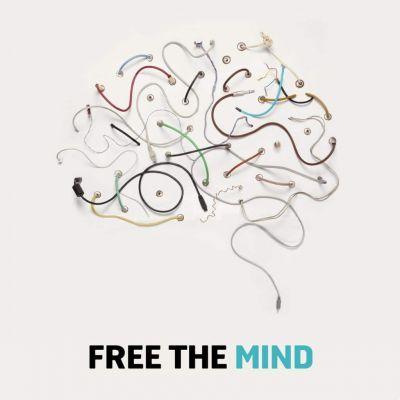You might also like:
- The psychological meaning of colors in humans
- How our brain identifies colors
- What is the relationship between selfishness and color blindness?
But have you ever stopped to ask yourself: what is color blindness or how does a color blind person see? Or even: does everyone see the same or are there variations in the confusion with colors? We will clarify your doubts about color blindness in this article.
What is color blindness?
Dyschromatopsia, popularly known as color blindness, is a color vision disorder that is characterized by the non-functioning of photoreceptor cells in the retina. It is these cells, called eye cones, that differentiate colors.

The name “color blindness” is a reference to the chemist John Dalton, who suffered from a type of dyschromatopsia and was the first scientist to research the subject. According to data from the World Health Organization (WHO), it is estimated that about 5% of the world population has color blindness. In Spain alone, there are more than 8 million color blind people (data also from the WHO).
The most common cause of color blindness is hereditary, due to genetic changes (congenital color blindness). But there are external causes that can lead to the development of the deficiency, as they have the potential to damage the retina among the consequences. It's called acquired color blindness.
In this case, the main risk factors are: damage to the optic nerve or cerebral cortex (area of the brain responsible for image recognition), eye diseases (macular degeneration or glaucoma), retinal detachment or systemic diseases (such as diabetes). Other pathologies that can also contribute to the unfolding of the problem: Alzheimer's disease, Parkinson's disease, leukemia, sickle cell anemia, Kallmann syndrome and Leber's hereditary optic neuropathy.

People exposed to certain chemicals – such as carbon sulfide and some fertilizers – are believed to be more susceptible to color blindness. Medications used to treat high blood pressure and some psychological disorders are also among the risk factors, with the ability to increase the chances of developing color blindness.
In the congenital form, color blindness is caused by a “defective” gene on the X chromosome. For it to manifest in a woman, both X genes must be carriers of the disorder. For men (XY), only one needs to present the problem. It is for this reason that the occurrence of color blindness is much higher in men (approximately 8%) than in women (less than 1%).
There is no cure for hereditary color blindness, but the colorblind eventually learns to differentiate between colors and to live with this condition. Depending on the level of color blindness, corrective lenses can be used.
Diagnosis
There are currently 4 methods for diagnosing color blindness, the type and degree of the disorder:
Nagel anomaloscope – is a device that emits a yellow light in the middle of the visual field. On the other half, green and red monochromatic lights appear. The patient must make an adjustment to match the colors of the two visual fields. It basically works as a comparison between the real colors and the one visualized by the patient.
Holmgreen wool: colored wool that the patient must group according to some criteria. The diagnosis will be based on the type of color classification failure.
Ishihara Color Test: is the main method used. Basically they are dotted cards with several different shades, with letters, figures or numbers drawn in the center. Those with normal vision can see these central elements. The colorblind will have difficulty identifying them.
Farnsworth-Munsell 100 shade test: it is a more difficult test, which assesses the person's ability to arrange the colored pieces in the correct sequence. It is also used to detect the degree of visual acuity and other visual impairments.

revolutionary initiative
The Japanese multinational Canon (the giant manufacturer of cameras, printers, video cameras, among other high-end equipment) created a color perception test based on the Ishihara Test called “ABC for Colorblind People”.
It is a revolutionary initiative that aims to help parents and teachers detect signs of color blindness in children. To facilitate its use, the exam was incorporated into the printing test of one of the company's printer models. Thus, at the end of printing, the result is the creation of an alphabet book with 26 letters, which, in addition to helping to identify the traits of color blindness, also checks if everything is ok with the printer.
Types of color blindness
But then you ask yourself: “Is it all the same?”. No, color blindness is characterized by difficulties in distinguishing certain colors – particularly red and green or blue and yellow. But it's not all the same. There are three types of color blindness:
Achromatic color blindness: it is the rarest type. In this type, the colorblind only sees black, white and gray, not being able to recognize any other color.
dichromatic color blindness in this case, the colorblind person does not have all the color receptors, thus not being able to identify one of the three colors. It is subdivided into three categories: protanopia (difficulty recognizing the color red), deuteranopia (difficulty seeing the color green) and tritanopia (difficulty perceiving the color blue). These are total deficiencies in each cone.
Trichromatic color blindness: is the most common type. It is subdivided into: protanomaly (partial deficiency in the red receptor), deuteranomaly (partial deficiency in the green receptor) and tritanomaly (partial deficiency in the blue receptor). In this case, they are partial deficiencies, that is, the colorblind person has the receptors, but they do not work perfectly. So they see colors, but with different contrast and saturation.

How does the colorblind see the world?
After knowing that there are different types of color blindness, you may be wondering, then, how each type of color blindness perceives the world. To know how a color blind person can see colors, we need to understand what type of color blindness he is.
In protanopia, the colorblind person sees shades of brown/sepia, green or gray in place of red. In deuteranopia, instead of green, he sees brown. In tritanopia, the perception of blue and yellow is distorted: blue is seen in a different hue than the original, yellow is seen as pink and the colorblind cannot perceive orange.
In protanomaly, as the deficiency is around reds, it results in a lower sensitivity and darkening of that color and similar tones. Colorblind people of this type can confuse red and black. In deuteranomaly, there is difficulty in distinguishing green. In the case of tritanomaly, as there is a problem with the blue receptors, there is a loss in the identification of colors in the blue and yellow range.
There is a site that makes a simulation with all types of color blindness, both total and partial disabilities, in addition to the rarest, which is achromatic color blindness. It's worth checking out, to know, in practice, what colors really are like in the life of a colorblind: http://www.color-blindness.com/coblis-color-blindness-simulator/.

























